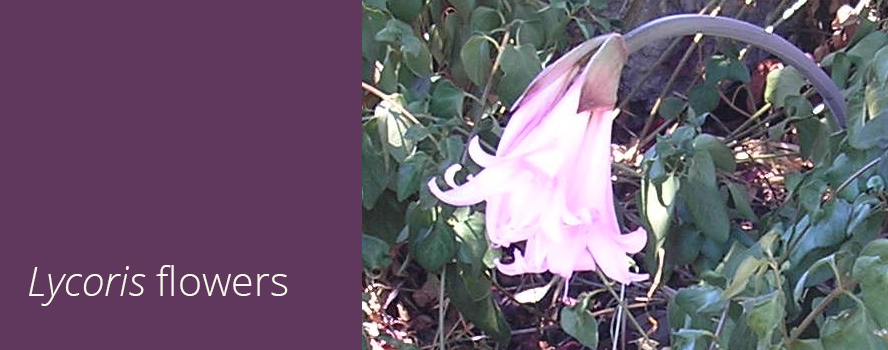The Magic Lily—a Drought Tolerant Species of Lycoris
by Helga George, Ph.D.
The flower bulb that is also known as a resurrection lily produces showy clusters of pink flowers seemingly out of nowhere after its foliage has died back.
Lycoris squamigera, a relative of the Amaryllis, is a remarkable plant. It is part of a genus that has been grown for centuries in Asia. This particular species of Lycoris is adapted for regions that receive winter and spring rains, then have drought the rest of the year. Requiring no care in regions like that of southern California, leaves like that of the Amaryllis plant are produced in the spring, then disappear. Suddenly, in mid summer, clusters of large pink flowers appear on two-three foot (0.6-0.9 m) stems.
Drought Tolerant, Low Maintenance, Perennial Garden Bulb Flowers
This species of Lycoris has many names because of its unusual style of growth. It is known as the magic lily, resurrection lily, surprise lily, hurricane lily, and naked lady, among others. In warm, drought-prone regions, the magic lily is best planted under a deciduous tree, so it gets some shade from the hot summer sun. In less drought-prone areas in the northernmost part of its range, such as Illinois or Iowa, Lycoris squamigera grows well in full sun or partial shade.
The plant is remarkably maintenance free and drought tolerant, even in southern California. It does not require fertilization. The only negative is that the large two feet (0.6 m) leaves die back and can be ugly. It is recommended to plant the flower bulbs 4-6 inches (10-15 cm) deep among other perennials, so the dead leaves are hidden. The alternate photograph below was taken of a magic lily flower stalk in a bed of periwinkle ground cover, which nicely hid the dead foliage in the spring.
One tends to entirely forget about this flower bulb until July or August, when the large stems appear, producing clusters of six to eight bright pink trumpet-shaped flowers. The presence of large, ungainly stems is another reason to plant the bulbs amongst other greenery. The magic lily is so low maintenance that it often remains long after a house has decayed.
Lycoris Squamigera is a Fragrant Lily that can be Grown as a Flowering House Plant
In addition to the beauty of the pink flowers, they also have a pleasant fragrance and make excellent cut flowers. This fragrant lily can be grown indoors as a flowering house plant in colder areas of the country. This species of Lycoris is the most cold hardy, but estimates of its range vary. The plant has frequently been interbred with other species, making it difficult to exactly delineate conditions such as cold-hardiness.
As indoor flowering houseplants, magic lily bulbs should be planted one per pot in late summer. After they have bloomed in the fall, the plants should be left to grow until early summer. One should then allow them to dry and then start watering again in late summer. The pots should be kept from freezing.
Easy to Grow Lily Bulbs for the Perennial Garden
The magic lily is a flower bulb that is easily grown in a temperate climate perennial garden from Asia to the United States or indoors as a flowering houseplant. It has a variety of names such as surprise lily because the plants bloom unexpectedly in the summer long after their leaves have died. This fragrant lily grows best in climates that have winter and spring rains, followed by summer droughts. The plant is very low-maintenance and drought tolerant, and its showy blooms often come as a complete surprise.
Sources:
Crockett, J.U and the editors of Time-Life Books. 1971. “The Time-Life Encyclopedia of Gardening: Bulbs.” Time-Life Books, NY.
Jauron, P. August 6, 2007. “Late Summer and Fall-Blooming Bulbs.” Iowa State University Extension News. extension.iastate.edu, accessed August, 2010
Klingaman, R. August 1, 2003. “Plant of the Week: Surprise Lily, Magic Lily, Naked Lady.” University of Arkansas Cooperative Extension Service. aarhomeandgarden.org, accessed August, 2010
Mason, S. August 18, 2005. “The Surprise in Surprise Lilies.” University of Illinois Extension, web.extension.illinois.edu
QUICK LINKS TO ALL
Suite.io Articles
by Helga George, Ph.D.
AGRICULTURAL SCIENCE
• Polyphenol Oxidase Enzymes Cause Browning of Fruits and Vegetables
CHEMICAL ECOLOGY
• Domoic Acid Poisoning in Sea Lions
• Insects that Make Cyanide
PLANT PATHOLOGY
• Plants Produce Chemicals as a Defense Against Pathogens
• Wheat Rust Threatens World’s Wheat Crops
• Biotrophic Versus Necrotrophic Fungi
• Fungal Haustoria Absorb Nutrients from Living Plant Cells
• The Gene-for-Gene Concept: a Central Tenet in Plant Pathology
GARDENING
• Oenothera speciosa—a Drought Tolerant Perennial Groundcover
• The Magic Lily—a Drought Tolerant Species of Lycoris
SOIL MICROBIOLOGY
• Streptomyces, Antibiotics, and Microbial Conflict in the Soil
AGRICULTURE IN SANTA BARBARA COUNTY
• Chrysanthemum White Rust Outbreak in Southern California

